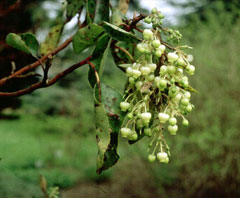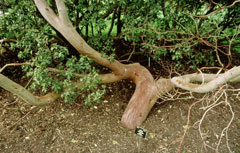 |
|
(c) 2010 Ken Fern & Plants For A Future |
 |
| (c) 2010 Ken Fern & Plants For A Future |
Translate this page:
Summary
Physical Characteristics

 Arbutus andrachne is an evergreen Tree growing to 6 m (19ft) by 6 m (19ft) at a slow rate.
Arbutus andrachne is an evergreen Tree growing to 6 m (19ft) by 6 m (19ft) at a slow rate.
See above for USDA hardiness. It is hardy to UK zone 8. It is in leaf all year, in flower from March to April, and the seeds ripen from September to October. The species is hermaphrodite (has both male and female organs) and is pollinated by Bees. The plant is self-fertile.
Suitable for: light (sandy) and medium (loamy) soils and prefers well-drained soil. Suitable pH: mildly acid, neutral and basic (mildly alkaline) soils. It cannot grow in the shade. It prefers dry or moist soil and can tolerate drought.
UK Hardiness Map
US Hardiness Map
Synonyms
Plant Habitats
Woodland Garden Secondary; Sunny Edge; Hedge;
Edible Uses
Edible Parts: Fruit
Edible Uses:
Fruit - raw or cooked[2, 22, 46, 105, 183, K]. A luscious, juicy texture with a sweet but insipid flavour[K]. Many people do not like eating more than a few of the raw fruits, though I find them very acceptable[K]. They make a good cooked fruit in preserves etc[K]. The fruit is about 15mm in diameter[200].
References More on Edible Uses
Medicinal Uses
Plants For A Future can not take any responsibility for any adverse effects from the use of plants. Always seek advice from a professional before using a plant medicinally.
None known
References More on Medicinal Uses
The Bookshop: Edible Plant Books
Our Latest books on Perennial Plants For Food Forests and Permaculture Gardens in paperback or digital formats.

Edible Tropical Plants
Food Forest Plants for Hotter Conditions: 250+ Plants For Tropical Food Forests & Permaculture Gardens.
More

Edible Temperate Plants
Plants for Your Food Forest: 500 Plants for Temperate Food Forests & Permaculture Gardens.
More

More Books
PFAF have eight books available in paperback and digital formats. Browse the shop for more information.
Shop Now
Other Uses
References More on Other Uses
Cultivation details
Requires a nutrient-rich well-drained moisture-retentive soil in a sunny position with shelter from cold drying winds, especially when young[200]. Requires a lime-free soil according to some reports[1, 134], but it thrives on a limy soil according to other reports[11, 182, 200]. Established plants are drought tolerant. Plants are hardy to about -15°c[184]. The flowers are sweetly scented[245]. Dislikes being transplanted, it should be placed in its final position whilst young, giving some protection in its first winter outdoors[11, 134]. Plants are very slow growing. Most plants cultivated under this name are in fact A. x andrachnoides 'Serratula'[200].
References Carbon Farming Information and Carbon Sequestration Information
Temperature Converter
Type a value in the Celsius field to convert the value to Fahrenheit:
Fahrenheit:
The PFAF Bookshop
Plants For A Future have a number of books available in paperback and digital form. Book titles include Edible Plants, Edible Perennials, Edible Trees,Edible Shrubs, Woodland Gardening, and Temperate Food Forest Plants. Our new book is Food Forest Plants For Hotter Conditions (Tropical and Sub-Tropical).
Shop Now
Plant Propagation
Seed - best surface sown in a cold frame as soon as it is ripe. Stored seed should be soaked for 5 - 6 days in warm water and then surface sown in a shady position in a greenhouse[78]. Do not allow the compost to become dry. 6 weeks cold stratification helps[134]. The seed usually germinates well in 2 - 3 months at 20°c[134]. Seedlings are prone to damp off[184], they are best transplanted to individual pots as soon as they are large enough to handle and should be kept well ventilated. Grow them on in a greenhouse for their first winter and then plant out in late spring after the last expected frosts[K]. Basal cuttings in late winter[200]. Cuttings of mature wood of the current season's growth, November/December in a frame. Poor percentage[78]. Layering of young wood - can take 2 years[1, 200].
Other Names
If available other names are mentioned here
Native Range
TEMPERATE ASIA: Cyprus, Israel, Jordan, Lebanon, Syria, Turkey, Georgia EUROPE: Ukraine (Krym), Albania, Bulgaria, Greece (incl. Crete), Croatia, North Macedonia
Weed Potential
Right plant wrong place. We are currently updating this section.
Please note that a plant may be invasive in one area but may not in your area so it's worth checking.
Conservation Status
IUCN Red List of Threatened Plants Status :

Growth: S = slow M = medium F = fast. Soil: L = light (sandy) M = medium H = heavy (clay). pH: A = acid N = neutral B = basic (alkaline). Shade: F = full shade S = semi-shade N = no shade. Moisture: D = dry M = Moist We = wet Wa = water.
Now available:
Food Forest Plants for Mediterranean Conditions
350+ Perennial Plants For Mediterranean and Drier Food Forests and Permaculture Gardens.
[Paperback and eBook]
This is the third in Plants For A Future's series of plant guides for food forests tailored to
specific climate zones. Following volumes on temperate and tropical ecosystems, this book focuses
on species suited to Mediterranean conditions—regions with hot, dry summers and cool, wet winters,
often facing the added challenge of climate change.
Read More
Expert comment
Author
L.
Botanical References
1150200
Links / References
For a list of references used on this page please go here
Readers comment
| Add a comment |
|
If you have important information about this plant that may help other users please add a comment or link below. Only comments or links that are felt to be directly relevant to a plant will be included. If you think a comment/link or information contained on this page is inaccurate or misleading we would welcome your feedback at [email protected]. If you have questions about a plant please use the Forum on this website as we do not have the resources to answer questions ourselves.
* Please note: the comments by website users are not necessarily those held by PFAF and may give misleading or inaccurate information.
To leave a comment please Register or login here All comments need to be approved so will not appear immediately.
|
Subject : Arbutus andrachne
|
|
|
|